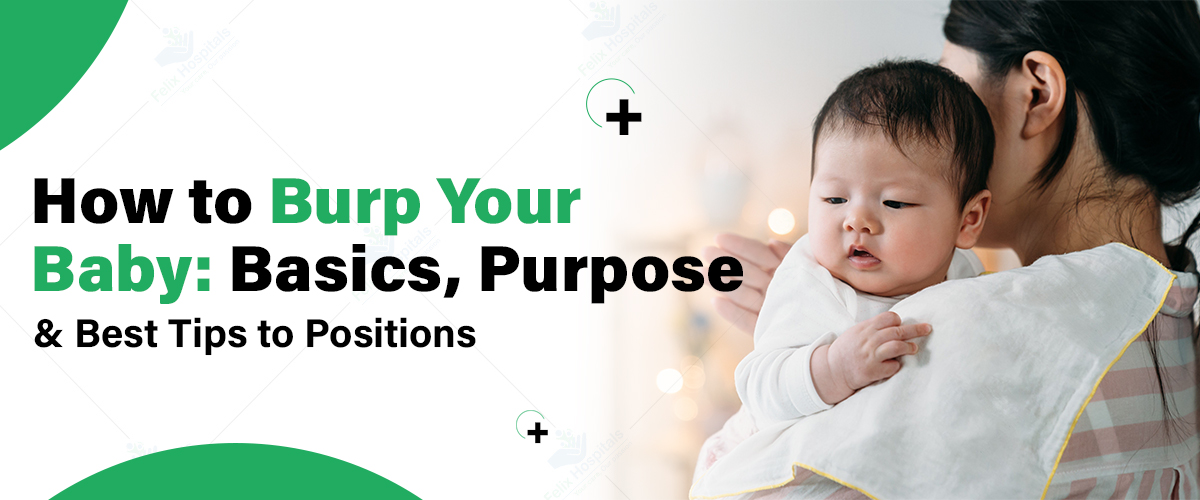
Subscribe to our

As a new parent, you might notice your baby becoming fussy or irritable during or after feedings. This discomfort is often caused by swallowed air, which can make your little one feel uncomfortably full. Burping is an essential step in the feeding process that can help alleviate this discomfort and ensure your baby's comfort.
Let’s explore why burping is important, how to do it effectively, and answer some common questions about this crucial parenting technique.
Need expert advice on breastfeeding and burping? Call +91 9667064100 for personalized guidance!
Burping plays a vital role in your baby's comfort and overall feeding experience. Here's why it's so crucial:
Burping your baby is an essential part of the feeding process, helping to release any trapped air that might cause discomfort. To ensure a successful burp, follow these steps to make the process smooth and effective:
Burping positions can vary depending on what is most comfortable for each baby. However, there are three effective positions that generally work well for most babies:
1.) On Your Shoulder
2.) Face-Down on Your Lap
3.) Sitting Up
The frequency of burping can vary depending on whether you're bottle-feeding or breastfeeding:
For Bottle-Fed Babies
For Breastfed Babies
Don't worry if your baby doesn't burp every time. Some babies don't swallow much air during feeding and may not need to burp as frequently. If your baby seems comfortable and isn't overly bothered by gas, it's generally not a cause for concern.
Dr. Shweta Upadhyay
Dr. Shweta Upadhyay is a renowned childbirth educator with specialized expertise in guiding new parents through the complexities of breastfeeding and baby care. Her insights on effective breastfeeding techniques, burping methods, and essential newborn tips empower parents to foster a nurturing and healthy start for their babies. Dr. Upadhyay’s compassionate approach and practical advice make her a trusted resource for navigating the early stages of parenthood with confidence.
Burping is a simple yet crucial aspect of caring for your baby. It can significantly improve your little one's comfort during and after feedings, leading to a happier baby and more enjoyable feeding times for both of you. Remember, every baby is different, so it may take some time to find the burping technique that works best for your little one. With patience and practice, you'll soon become a burping expert!
Remember, if you have any concerns about your baby's feeding or comfort, don't hesitate to consult with your pediatrician. They can provide personalized advice based on your baby's specific needs and health status.
For expert tips on breastfeeding and burping, reach out to +91 9667064100 and get the support you need today!
1.) How often should you burp your baby while breastfeeding?
You should burp your baby after every 2-3 ounces of milk or when you switch breasts during breastfeeding. Frequent burping helps release any trapped air and can prevent discomfort or gas.
2.) Is burping necessary after breastfeeding?
While burping is not always mandatory, it is recommended to help release any swallowed air, which can reduce discomfort and fussiness. It’s a good practice to burp your baby to ensure they feel comfortable.
3.) Does burping mean the baby is full?
Not necessarily. Burping indicates that the baby has swallowed air, but it does not always mean they are full. Pay attention to your baby’s cues to determine if they need more feeding.
4.) At what age do you stop burping a baby?
Most babies outgrow the need for frequent burping around 4-6 months of age. As they develop better control over their digestive system, they typically swallow less air and may not need to be burped as often.
5.) What is the difference between burping and belching?
Burping and belching are terms often used interchangeably to describe the release of air from the stomach through the mouth. However, "burping" is commonly used for babies, while "belching" is more frequently used for adults.
6.) Should I stop feeding my baby if they spit up?
Spitting up is common and usually not a cause for concern. If your baby spits up, it’s generally fine to continue feeding. However, if you notice frequent or excessive spitting up, consult your pediatrician to rule out any issues.
7.) How to check if a baby's stomach is full?
A baby's fullness is usually indicated by signs of disinterest in feeding, turning away from the breast or bottle, or showing signs of contentment and satisfaction. You can also observe if the baby is relaxed and not actively seeking more milk.